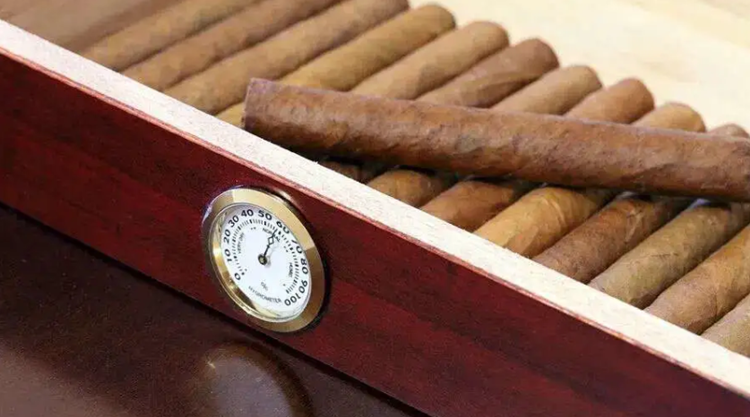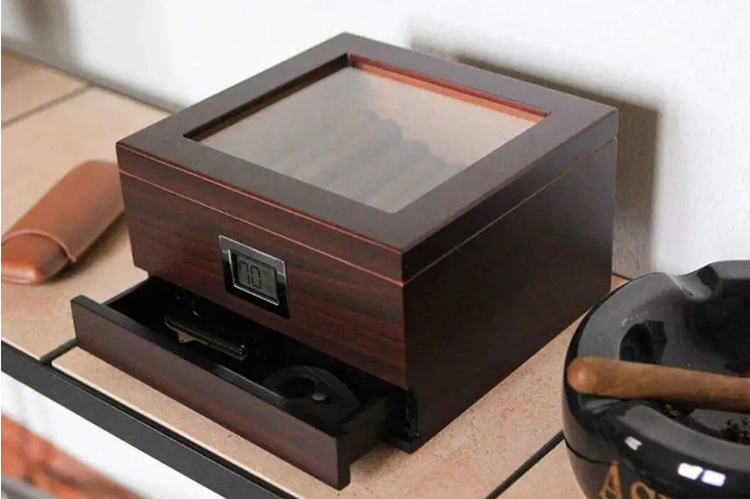Summer is the peak season for tobacco beetles, commonly known as cigar beetles (scientific name: Lasioderma serricorne).
Hot rooms and overly humid cigar boxes provide a perfect growth environment for tobacco beetles.
The most terrifying thing about cigar beetles is their larvae, which can hide in cigar tobacco and then make deep and shallow holes in cigars at lightning speed.
Some cigar lovers may find it incredible that cigars I bought at a high price still have bugs?
In fact, cigar beetle larvae have the incredible ability to produce a glycol compound in the cold, which acts as an antifreeze to prevent them from freezing.
Only when the freezing process is fast, the larvae have no chance to protect themselves.
Professional and qualified Cuban Habanos distributors and importers will freeze the cigars to at least -32 to -40°C for several days immediately after receiving them. Rapid freezing reliably kills the beetle larvae, and the emphasis is on "fast".
——So, check your cigars frequently in the summer to see if they have insects. The potential information has surpassed the meaning of the matter itself.........
Of course, the trouble caused by high temperatures is not only insects, but also humidity will quickly accumulate in the humidor in the next few months, which can easily cause mold and rot on cigars.
Temperature fluctuations in the range of 15 to 30°C will not damage cigars. When the air humidity fluctuates, the situation is very different.Especially for premium hand-rolled cigars, they are very sensitive to humidity changes - even a few percentage points of relative humidity increase can have a significant impact on the feel, taste and age of the cigars.
Of course, the trouble caused by high temperatures is not only insects, but also humidity will quickly accumulate in the humidor in the next few months, which can easily cause mold and rot on cigars.
Temperature fluctuations in the range of 15 to 30°C will not damage cigars. When the air humidity fluctuates, the situation is very different. Especially for premium hand-rolled cigars, they are very sensitive to changes in humidity - even a few percentage points of relative humidity increase can have a significant impact on the feel, taste and age of the cigar.
The warmer it is, the faster the moisture will flow than in a colder environment, and the more uncontrollable factors are. For example, if the cigar is too wet, the tobacco leaves will swell, causing problems such as poor draw.
Cigars are mostly in March, April, May and June, and are more likely to bloom.
If there are cigars that are aging, you can check them more thoroughly every few months. Gently squeeze the cigars to ensure that they are properly humidified and that the cigar wrappers do not crack or peel off easily.
Make sure there is no mold in the cigar box. Any blue or green substances are bad. If you happen to find any moldy cigars, discard them immediately, otherwise the bacteria will spread rapidly.
Rotate the cigars. It is very simple and effective to avoid always keeping the same cigars closest to the humidification source. You can rotate the cigars in the box every two weeks or at least once a month, moving cigars from the upper row to the lower row and vice versa.
At the same time, don't fill the humidor box too full. Ideally, leave 20-25% of the space in the box to promote air and moisture flow around the cigars (you can use cedar wood chips to separate strong and light cigars).
If you find any loose tobacco or debris in the box, clean it out as soon as possible. Check the cigar box itself for signs of mold or cigar beetles. Check the humidifier to make sure it maintains humidity and does not emit odors or leak.
Cigars are like sponges and absorb what is around them. That's why we recommend storing premium hand-rolled cigars in one place and cigars with added spices in another.
Sprinkling coffee beans in the cigar box and injecting whiskey and Moutai into cigars is even more unnecessary, because everything about the tobacco leaves will change.

Store cigars in an air-conditioned room to adjust the desired temperature for whiskey cigars. But if you blow 24 hours a day, don't forget to pay the electricity bill - you may have to replenish the humidification solution required for the humidifier more frequently than usual, because the air conditioner will suck moisture directly from the room.
If you are in an area with humid summers and don't use air conditioning, you may not need to refill the humidifier all summer, and you may need to turn it on for an hour or so every day. At the same time, you need to pay attention to the temperature inside the box and keep it as cool as possible, away from direct sunlight, to avoid cigar bugs.
The cigar humidor is designed to keep cigars moist. In order to perform this basic function, the cigar humidor itself must first achieve a perfect humidity balance. Otherwise, it is typical that the cigar humidor will absorb moisture from the cigars and dry them out. If the humidor is not made entirely of cedar, at least it should have a cedar lining.
Depending on the size, material and humidification method of the box, it usually takes 3-5 days to reset the new cigar humidor, and it can take two weeks. In short, it is a step-by-step process.
The specific steps generally include: calibrating the hygrometer, replenishing the humidifier (usually propylene glycol solution or distilled water), wiping the inside of the box with a clean sponge or a rag dampened with distilled water, checking the humidity level in the box after 3-5 days (or longer) until the box absorbs the right amount of initial humidity (75%-80% relative humidity), loading cigars, and regular maintenance.
Digital hygrometers, which are more popular nowadays, can provide more accurate readings.
Precise control of humidity is not only to ensure the basic quality of cigars, but also to control the taste.

Cigar lovers generally believe that the lower the humidity level, the more flavorful the cigars tend to be, and the burning ability will also be improved (no need to relight a second time, etc.).
In other words, generally lower humidity = better burning, more discernible taste; generally higher humidity = more frequent relighting, hotter/cloudier/harsher taste. Rumor has it that Min Ron Née keeps the cigar humidity at around 55%.
However, while a hygrometer tells us about the air in the cigar box, a more accurate measurement is the moisture content of the leaves themselves, and to test this, you need a humidometer.
A tiny, pointed device that you can carry with you to detect how much moisture is in a cigar.
Then the question is, why do you need to measure the moisture content of cigars? What percentage of moisture content is better?
It is understood that Cuban cigars are stored at 16°C in the factory for several weeks after production and before packaging, because the moisture content of tobacco leaves after rolling is still around 17% to 18%.
Storing at lower temperatures will cause the excess moisture to evaporate slowly until the tobacco reaches about 12-13% humidity, which is the optimal humidity content (but not absolute, for example, I heard that Min Ron Née prefers 11% moisture content in cigars).
Cigar lovers who like to study tobacco can try the effects of different moisture contents on tobacco flavor and combustion. It will be an interesting process to find your favorite one.
We chat
